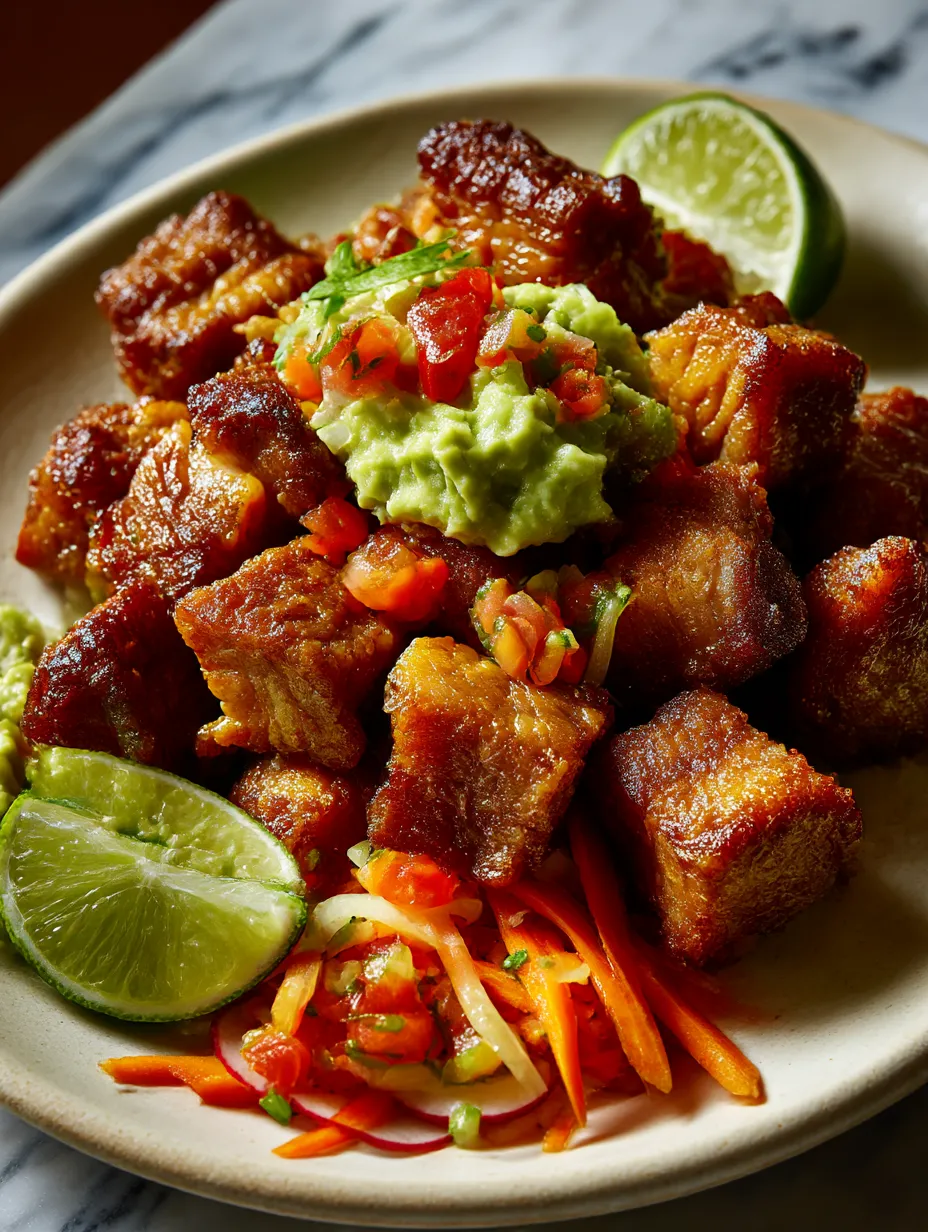 Save
Save
Chicharrones bring a celebration mood to any table with their crunchy skin and juicy, savory pork. They are slow-cooked to golden perfection and enjoyed with salsa or just as they are. These pork belly cracklings hold a special spot for gatherings with friends and are always the first snack to disappear at parties.
I first learned to make chicharrones from my aunt who would fry up a batch for family potlucks. The aroma would fill the kitchen and everyone would sneak pieces before they fully cooled no matter the warnings.
Ingredients
- Pork belly with skin on: delivers rich flavor and the essential crackling texture Choose a piece with a good balance of fat and meat for best results
- Garlic cloves: infuse the pork with savory aroma Use fresh unpeeled garlic for milder taste
- Bay leaves: provide subtle herbal notes that cut through the richness Look for whole green leaves
- Lime peel and juice: add tang and brightness Pick a firm heavy lime and zest it lightly
- Salt: seasons the pork and enhances crispiness Use coarse salt if possible
Step-by-Step Instructions
- Prepare the Pork:
- Slice pork belly into thick strips about two inches wide Make deep cuts into the meat side of each strip being careful not to pierce the skin This helps the fat render and flavors absorb
- Flavor Base:
- Put the pork belly strips into a large heavy pot Add garlic cloves bay leaves lime peel lime juice and salt over the meat Mix everything together so the flavors start to combine
- Simmer and Render Fat:
- Pour enough water to just cover the meat Bring to a boil over medium heat Leave the pot uncovered and allow the pork to simmer Stir occasionally for forty to fifty minutes until almost all water evaporates
- Begin Frying:
- Lower heat to medium low Once the water is nearly gone the fat will start to render Continue cooking for thirty minutes turning the strips every ten minutes as more fat cooks out
- Crisp and Finish:
- Keep turning the pork with tongs so every side fries evenly Continue for another thirty minutes Watch closely as the pork turns deep golden and the skin bubbles and crisps
- Cool Off:
- Use a slotted spoon to remove chicharrones to a wire rack Let them rest for ten minutes so the texture fully crisps Cut into bite-size pieces when cool Serve warm or save for later
 Save
Save
The best chicharrones always remind me of bustling family gatherings with everyone reaching for the last crispy bite. My favorite part is that first fragrant crunch when you break a cooled chicharron in half and see the steam rise.
Storage Tips
Keep leftover chicharrones in an airtight container at room temperature for up to two days. For longer storage refrigerate and re-crisp them in a hot oven for several minutes to restore crunch. They also freeze well—just thaw and bake from frozen to reheat.
Ingredient Substitutions
If you cannot find pork belly with skin you can use skinless but expect less crunch. For extra richness add a pinch of smoked paprika to the simmering pot. Lemon can substitute for lime but use slightly less juice.
Serving Suggestions
Chicharrones are delicious on their own alongside spicy salsa or with a bright cabbage slaw to cut the richness. They are also great with cold drinks or as a topping on rice beans and even salads for added crunch.
Cultural and Historical Context
Chicharrones are beloved throughout Latin America and Spain each region with its own twist from seasoning blends to serving methods. In many Mexican homes they mark celebrations and casual afternoons alike and sharing them is a gesture of friendship and abundance.
Frequently Asked Questions About Recipes
- → How do you keep chicharrones extra crispy?
Allow them to cool on a rack instead of paper towels to avoid steam and maintain maximum crunch. Letting them rest helps enhance the texture even more.
- → What is the best way to cut pork belly for chicharrones?
Slice the pork belly into 2-inch wide strips and make deep cuts on the meaty side without cutting through the skin to help even cooking and crispy results.
- → Can I use other seasonings instead of bay leaves and garlic?
Yes, you can customize the flavor by adding chili powder, cumin, or other spices, but classic bay leaves and garlic provide a traditional profile.
- → What should I do with the leftover pork fat (manteca)?
The rendered fat from frying can be saved and used to add flavor to dishes like tamales, refried beans, or sautéed vegetables.
- → How do I know when chicharrones are ready?
They are ready when dark golden brown, with the pork rind bubbly and nicely crispy. Watch closely near the end to avoid burning.
